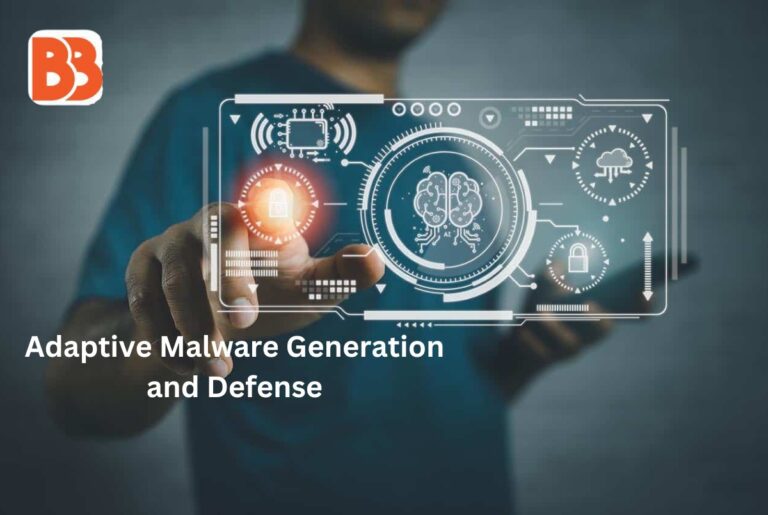One of the most alarming developments in recent years is the rise of adaptive malware Generation and Defense that can learn, evolve, and outmaneuver traditional security measures. This is no longer a fight between static systems; it’s an arms race fueled by artificial intelligence (AI). While attackers are leveraging AI to create more adaptive and elusive malware, defenders are also deploying AI-driven solutions to detect, mitigate, and neutralize these threats. This ongoing battle is reshaping the cybersecurity landscape. We’ll explore how AI is both a weapon for attackers and a shield for defenders in the fight against adaptive malware.
The Rise of Adaptive Malware
Traditional malware operates on predictable patterns. It often relies on preprogrammed commands or specific behaviors to achieve its objectives. Adaptive malware, however, represents a new breed. Powered by machine learning, it can modify its strategies based on its environment and the defenses it encounters.
Characteristics of Adaptive Malware
- Evasion Techniques: Adaptive malware can detect when it’s being analyzed in a sandbox environment and modify its behavior to avoid detection.
- Polymorphic Code: It can rewrite its code while maintaining functionality, making it harder for antivirus software to recognize.
- AI-Driven Decision Making: By analyzing the systems it infects, it can choose the most effective attack vectors in real time.
- Network-Aware Behavior: Adaptive malware can map out network structures and prioritize high-value targets within an organization.
Real-World Examples
- Emote: Originally a banking Trojan, Emote evolved into a modular malware platform capable of adapting its methods to bypass security measures.
- TrickBot: A malware variant that adapts its modules based on the target environment, enabling it to carry out a range of attacks, from credential theft to ransomware deployment.
The Role of AI in Malware Evolution
AI has significantly enhanced the capabilities of malware developers, making their creations more dangerous and harder to stop.
Generative Malware
Using generative adversarial networks (GANs), attackers can create entirely new malware strains that have never been seen before. These variants are designed to evade signature-based detection methods used by traditional antivirus systems.
Automated Target Analysis
AI enables malware to analyze its targets in real time, adapting its behavior to exploit specific vulnerabilities within a system. For example, it can prioritize exfiltration of sensitive financial data in a banking network while disabling backup systems to increase the effectiveness of ransomware.
Malware-as-a-Service (MaaS)
With AI-driven automation, the dark web has seen the rise of Malware-as-a-Service platforms, where attackers can customize malware with specific features and deploy it with minimal technical expertise.
AI-Powered Defenses: Fighting Fire with Fire
To counter the growing threat of adaptive malware Generation and Defense, cybersecurity professionals are turning to AI-driven defense mechanisms.
Behavioral Analytics
AI-powered systems analyze behavior rather than relying on static signatures. This approach enables detection of anomalies that might indicate malware activity, even if the malware is entirely new or polymorphic.
- Example: An AI system might detect unusual file access patterns or unexpected changes in network traffic, flagging them as potential threats.
Threat Intelligence Sharing
AI accelerates the process of gathering, analyzing, and distributing threat intelligence across organizations. This collaboration helps create a unified defense against evolving threats.
- Example: Machine learning models trained on global threat data can predict how malware might evolve and provide early warnings.
Real-Time Response
AI systems can respond to threats in real time, isolating infected systems, blocking malicious traffic, and neutralizing malware before it spreads.
- Example: Endpoint Detection and Response (EDR) solutions use AI to monitor devices continuously, allowing instant action against suspicious activity.
The Challenges of the AI Arms Race
While AI offers powerful tools for defense, the arms race between attackers and defenders poses several challenges:
- Resource Disparity: Large organizations can afford advanced AI-driven defenses, but smaller businesses and individuals may lack the resources to deploy similar technologies, leaving them vulnerable.
- False Positives: AI systems can sometimes misidentify benign activity as malicious, leading to false alarms and wasted resources. Balancing sensitivity and accuracy remain a key challenge.
- AI Weaponization: As defenders leverage AI, so do attackers. Cybercriminals can use AI to test their malware against security systems, refining it until it becomes undetectable.
- Ethical Concerns: The development of AI tools for cybersecurity must be carefully managed to prevent misuse by malicious actors. Ensuring these tools don’t fall into the wrong hands is an ongoing concern.
The Future of Adaptive Malware and AI Security
As the arms race between adaptive malware and AI defenses continues, both sides are likely to see significant advancements. Here’s what the future might hold:
- Autonomous Cybersecurity Systems: AI defenses may evolve into fully autonomous systems capable of detecting, responding to, and learning from attacks without human intervention.
- Predictive Threat Modeling: Future AI systems could simulate potential malware evolution, allowing organizations to prepare defenses before threats even emerge.
- Quantum Computing Integration: The rise of quantum computing could supercharge AI, enabling even more advanced defenses but also potentially creating more dangerous malware.
- Global Collaboration: International cooperation and AI-driven threat intelligence sharing will be essential to counteract the global nature of cyber threats.
Conclusion
The battle between adaptive malware and AI-driven defenses is a high-stakes game with global implications. As attackers and defenders both harness the power of AI, the line between offense and defense continues to blur. For cybersecurity professionals, the key lies in staying one step ahead anticipating the moves of attackers and leveraging AI to outsmart them. For organizations and individuals, investing in AI-powered defenses is no longer optional; it’s a necessity in the digital age. Theadaptive malware Generation and Defense and arms race in AI security is far from over, but with innovation, collaboration, and vigilance, the scales can tip in favor of defense, securing our increasingly interconnected world.
Read More:
Deepfake Detection and Mitigation: A Generative AI Approach Leveraging Generative AI for Cyber Threat Detection and Prevention
